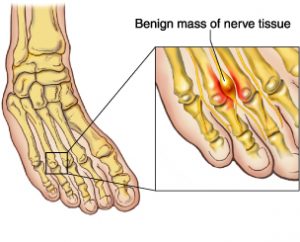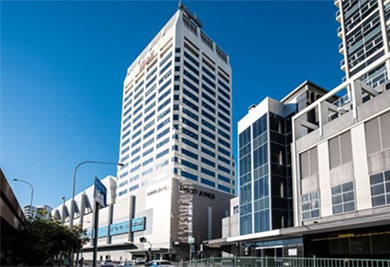What is a Morton’s Neuroma?
A Morton’s Neuroma is a perineural fibrosis, which means that over time the sheath surrounding the nerve between the toes becomes irritated, inflamed, and forms a thickened scar tissue.
Morton’s neuroma is a very painful condition at the ball of the foot. The good thing is that it is completely benign. In essence, the neuroma affects the nerves found between your metatarsal bones.
In the majority of cases, it occurs in middle-aged people, primarily women. The pain is caused by the thickening tissue around the nerve.
Morton’s Neuroma Symptoms
It usually occurs in between the 3rd and 4th toes (about 65% of cases) as is pictured to the right. It is less commonly found in the 2nd web space, and rarely at all in the 1st or 4th web spaces. You can also experience pins and needles and/or numbness as a result of the nerve being affected. The condition tends to occur predominantly in middle aged females.
What Causes a Morton’s Neuroma?
A Morton’s Neuroma are a result of complex biomechanical changes that occur in your feet. There are a number of theories as to the exact cause of the scarring and thickening, but it basically boils down to overload of the tissue structure. The body lays down scar tissue to try to protect the overloaded structure.
Tight-fitting shoes may exacerbate a Morton’s Neuroma. Shoes such as high heels and shoes with tight toe boxes like high heels are particularly damaging to the toes. These shoes have a sloping foot bed and a narrow toe box. The slope causes the front of the foot to bear your weight. The angle of the toe box then squeezes your toes together.
Footwear is not the only cause of a Morton’s Neuroma. Injuries to the foot can also be a factor in developing the condition by changing your foot biomechanics. Poor foot arch control leading to flat feet or foot over pronation does make you biomechanically susceptible to a neuroma.
Morton’s Neuroma Treatment
PHASE I – Pain Relief. Minimise Swelling & Injury Protection
Pain is the main reason that you seek treatment for a neuroma. Analgesics may help. Inflammation it best eased via ice therapy and techniques or exercises that deload the inflammed structures. Anti-inflammatory medications may help.
Your Podiatrist will use an array of treatment tools to reduce your pain and inflammation. These include: ice, EWST Shockwave therapy, deloading taping techniques, and orthotics to offload the irritated nerve.
One of the biggest factors in relieving pain may be changing or modifying your footwear. This may mean adding felt, foam or gel products to your shoe to help offload the area, or looking at avoiding tight fitting heels or shoes.
Metatarsal domes are often very useful.
Sometimes a corticosteroid injection is required to help settle the inflammation surrounding the nerve but there are risks with this therapy technique.
PHASE II – Restoring Normal ROM & Posture
As your pain and inflammation settles, your podiatrist will turn their attention to restoring your normal toe and foot joint range of motion and muscle length.
Treatment may include joint mobilisation and alignment techniques, muscle and joint stretches, EWST Shockwave therapy, taping, or orthotic.
PHASE III – Restore Normal Muscle Control & Strength
Your foot posture muscles are vital to correct the biomechanics that led to the overload injury. Your podiatrist will assess your foot posture muscles and prescribe the best exercises for you specific to your needs.
PHASE IV – Restoring Full Function
During this stage of your rehabilitation is aimed at returning you to your desired activities. Everyone has different demands for their feet that will determine what specific treatment goals you need to achieve. For some it be simply to walk around the block. Others may wish to run a marathon or return to a labour-intensive activity. Your podiatrist will tailor your rehabilitation to help you achieve your own functional goals.
PHASE V – Preventing a Recurrence
A Morton’s Neuroma may recur with repeated overload. The main reason is biomechanical. In addition to your muscle control, your physiotherapist will assess your foot biomechanics and may recommend custom made orthotics. You should avoid wearing high heel shoes and shoes with tight or angular toe boxes.
Morton’s Neuroma Surgery
Surgery is occasionally required when the conservative treatment is not able to relieve your symptoms, particularly if you have had pain for more than 6 months. 80% of patients who require surgery report good results, with 71% of people becoming pain-free.
What Are the Signs and Symptoms of Morton’s Neuroma?
If you start experiencing burning pain at the ball of your foot without any swelling, there’s a chance that it is the case of Morton’s neuroma. Also, the pain can radiate towards your toes, making them feel numb with a tingling sensation.
How is Morton’s Neuroma Diagnosed?
Diagnosing Morton’s neuroma is straightforward. After the symptoms are shared with the specialist, he or she will examine your foot. The specialist will search for the Mulder’s sign.
The sign is a clicking sound produced by your metatarsal bones. In patients with Morton’s neuroma, the sound is produced when the pressure is applied to the sides of the patient’s foot while the thumb of the other hand is pushing the bottom part of the foot.
What is the Non-operative Treatment for Morton’s Neuroma?
Non-operative treatment of Morton’s neuroma is possible in several ways.
- Physical therapy
- Strengthening ankles and toes
- Putting ice next to the sore areas of the foot
- Loosening tendons and ligaments by regularly stretching
- Rest
- Custom made orthotics
- Corticosteroid injections
- Anti-inflammatory drugs
- Alcohol sclerosing injections – in some cases, this is a permanent solution.
What is the Operative Treatment for Morton’s Neuroma?
There are several types of surgeries available for Morton’s neuroma. The options on the table are:
- Decompressions surgery – making more room around the nerve by cutting tissue and ligaments to decrease pressure
- Cryogenic surgery – myelin sheath covering nerves and nerves killed by extremely cold temperatures
- Neurectomy – nerve tissue removal
What is the Recovery Process After Morton’s Neuroma Surgery?
The recovery process will depend on the type of Morton’s neuroma surgery type. However, it is safe to say that you will have to limit your movement for a certain period of time.
It is a good idea to use wider shoes after the surgery and to have some painkillers prepared. Don’t forget to keep that leg above your heart level when lying and keeping it up while sitting.
Is It Possible to Have More Than One Neuroma in a Foot at the Same Time?
While this is actually possible, it is extremely rare.
How Long to Recover From Morton Neuroma Surgery?
Recovery times vary greatly with the different types of Morton’s neuroma surgery types. Additionally, it also depends on how severe the condition was. The decompression surgery will require the shortest recovery period.
Neurectomy recovery time is going to be much longer. Especially if your incision is made on the bottom side of your foot. Usually, it takes from 1 to 6 weeks to recover. It depends on the incision size.
Can a Podiatrist Treat Morton’s Neuroma?
To answer shortly, yes! Podiatrists are experts that can help with Morton’s neuroma treatment.
How is Morton’s Neuroma Treated?
There are several ways in which Morton’s neuroma can be treated. This includes:
- Icing
- Deloading taping techniques
- ESWT shockwave therapy
- Orthotics
- Painkillers
- Corticosteroid injections
- Footwear modification
- Surgery.
What Can You Do to Prevent Recurrence?
Once your treatment of Morton’s neuroma is finished, there are steps you can take to prevent the pain from coming back. It is recommended to start wearing wider shoes and avoid high heels.
Additionally, depending on your case, you can use an orthotic to decompress the ball of your foot. Wearing padded socks and adding custom padding to your footwear is a great way to prevent recurrence of this condition.
When is Surgery Needed?
Only after all the non-surgical Morton’s neuroma treatments are ineffective should the surgery be performed. This usually occurs when the pain starts heavily affecting the patient’s quality of life.
When Should You See a Doctor?
As soon as you notice that you are experiencing foot pain that won’t go away, it is time to see a doctor. The sooner you start with the treatment, the higher the chance that you will have the problem solved without needing the surgery. On top of that, you get to keep all your nerves intact.
In case you are looking for Morton’s neuroma treatment near me, you can find us in Sydney CBD, Bon Junction, and Miranda. Feel free to book an appointment with us from any part of Australia. We will be more than happy to help you heal Morton’s neuroma.



